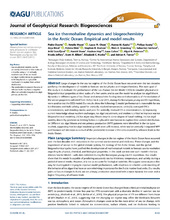| dc.contributor.author | Duarte, Pedro | |
| dc.contributor.author | Meyer, Amelie | |
| dc.contributor.author | Olsen, Lasse Mork | |
| dc.contributor.author | Kauko, Hanna Maria | |
| dc.contributor.author | Assmy, Philipp | |
| dc.contributor.author | Rösel, Anja | |
| dc.contributor.author | Itkin, Polona | |
| dc.contributor.author | Hudson, Stephen R. | |
| dc.contributor.author | Granskog, Mats A. | |
| dc.contributor.author | Gerland, Sebastian | |
| dc.contributor.author | Sundfjord, Arild | |
| dc.contributor.author | Steen, Harald | |
| dc.contributor.author | Hop, Haakon | |
| dc.contributor.author | Cohen, Lana | |
| dc.contributor.author | Peterson, Algot Kristoffer | |
| dc.contributor.author | Jeffery, Nicole | |
| dc.contributor.author | Elliott, Scott M. | |
| dc.contributor.author | Hunke, Elizabeth Clare | |
| dc.contributor.author | Turner, Adrian K. | |
| dc.date.accessioned | 2017-12-20T09:42:27Z | |
| dc.date.available | 2017-12-20T09:42:27Z | |
| dc.date.issued | 2017-07 | |
| dc.Published | Duarte P, Meyer A, Olsen LM, Kauko HM, Assmy P, Rösel A, Itkin P, Hudson SR, Granskog MA, Gerland S, Sundfjord A, Steen H, Hop H, Cohen L, Peterson AK, Jeffery, Elliott, Hunke EC, Turner. Sea ice thermohaline dynamics and biogeochemistry in the Arctic Ocean: Empirical and model results. Journal of Geophysical Research - Biogeosciences. 2017;122(7):1632-1654 | eng |
| dc.identifier.issn | 2169-8953 | en_US |
| dc.identifier.issn | 2169-8961 | en_US |
| dc.identifier.uri | https://hdl.handle.net/1956/17046 | |
| dc.description.abstract | Large changes in the sea ice regime of the Arctic Ocean have occurred over the last decades justifying the development of models to forecast sea ice physics and biogeochemistry. The main goal of this study is to evaluate the performance of the Los Alamos Sea Ice Model (CICE) to simulate physical and biogeochemical properties at time scales of a few weeks and to use the model to analyze ice algal bloom dynamics in different types of ice. Ocean and atmospheric forcing data and observations of the evolution of the sea ice properties collected from 18 April to 4 June 2015, during the Norwegian young sea ICE expedition, were used to test the CICE model. Our results show the following: (i) model performance is reasonable for sea ice thickness and bulk salinity; good for vertically resolved temperature, vertically averaged Chl a concentrations, and standing stocks; and poor for vertically resolved Chl a concentrations. (ii) Improving current knowledge about nutrient exchanges, ice algal recruitment, and motion is critical to improve sea ice biogeochemical modeling. (iii) Ice algae may bloom despite some degree of basal melting. (iv) Ice algal motility driven by gradients in limiting factors is a plausible mechanism to explain their vertical distribution. (v) Different ice algal bloom and net primary production (NPP) patterns were identified in the ice types studied, suggesting that ice algal maximal growth rates will increase, while sea ice vertically integrated NPP and biomass will decrease as a result of the predictable increase in the area covered by refrozen leads in the Arctic Ocean. | en_US |
| dc.language.iso | eng | eng |
| dc.publisher | American Geophysical Union | en_US |
| dc.rights | Attribution CC BY-NC-ND | eng |
| dc.rights.uri | http://creativecommons.org/licenses/by-nc-nd/4.0/ | eng |
| dc.title | Sea ice thermohaline dynamics and biogeochemistry in the Arctic Ocean: Empirical and model results | en_US |
| dc.type | Peer reviewed | |
| dc.type | Journal article | |
| dc.date.updated | 2017-12-14T10:04:08Z | |
| dc.description.version | publishedVersion | en_US |
| dc.rights.holder | Copyright 2017 The Author(s) | en_US |
| dc.identifier.doi | https://doi.org/10.1002/2016jg003660 | |
| dc.identifier.cristin | 1508429 | |
| dc.source.journal | Journal of Geophysical Research - Biogeosciences | |
| dc.relation.project | Utenriksdepartementet: ? | |
| dc.relation.project | Andre: Polarinstituttet Grant Numbers: 221961/F20 | |
| dc.relation.project | Norges forskningsråd: 244646 | |

